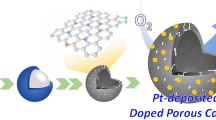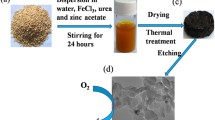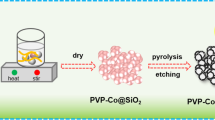Abstract
Seeking economical, efficient and stable catalysts to ameliorate the slow kinetics of oxygen reduction in cathode of proton exchange membrane fuel cells is still a great challenge. Herein, we design and synthesize an advanced Pd-based catalyst, where small palladium-phosphorus nanoparticles (Pd3P NPs) with ~ 5.2 wt% Pd loading are embedded in three-dimensional (3D) bubble-like nitrogen, phosphorus co-doped carbon (NPC) film (Pd3P@NPC). The resultant catalyst delivers markedly enhancive catalytic performance in comparison with commercial Pt/C, Pd/C, Pd3P and NPC toward ORR, benefiting from the specific 3D porous structure, nano-size effect and the electronic interaction between Pd3P NPs and NPC. Specifically, the half-wave potential of Pd3P@NPC (0.885 V) is 36 mV higher than that of commercial Pt/C, and the mass activity of Pd3P@NPC is 1.112 mA \({\mathrm{\mu g}}_{\mathrm{Pd}}^{-1}\) at 0.85 V, which is 8.18-fold and 11.96-fold enhancement in regard to that of commercial Pt/C and Pd/C, respectively. It is interesting to note that the as-prepared Pd3P@NPC also maintains a predominant stability after 40,000 potential sweeping cycles. This new catalyst is expected to enlarge the species of 3D Pd-based composites such as palladium carbide, palladium nitride and palladium sulfide on heteroatoms doped carbon substrate for ORR.





Similar content being viewed by others
References
Debe MK (2012) Electrocatalyst approaches and challenges for automotive fuel cells. Nature 486(7401):43–51. https://doi.org/10.1038/nature11115
Carrette L, Friedrich KA, Stimming U (2001) Fuel cells: fundamentals and applications. Fuel Cells 1(1):5–39
Wang YJ, Wilkinson DP, Zhang J (2011) Noncarbon support materials for polymer electrolyte membrane fuel cell electrocatalysts. Chem Rev 111(12):7625–7651. https://doi.org/10.1021/cr100060r
Ijaodola OS, El-Hassan Z, Ogungbemi E, Khatib FN, Wilberforce T, Thompson J, Olabi AG (2019) Energy efficiency improvements by investigating the water flooding management on proton exchange membrane fuel cell (PEMFC). Energy 179:246–267. https://doi.org/10.1016/j.energy.2019.04.074
Liang Y, Li Y, Wang H, Zhou J, Wang J, Regier T, Dai H (2011) Co(3)O(4) nanocrystals on graphene as a synergistic catalyst for oxygen reduction reaction. Nat Mater 10(10):780–786. https://doi.org/10.1038/nmat3087
Yu T, Kim DY, Zhang H, Xia Y (2011) Platinum concave nanocubes with high-index facets and their enhanced activity for oxygen reduction reaction. Angew Chem Int Ed 50(12):2773–2777. https://doi.org/10.1002/anie.201007859
Liu J, Yin J, Feng B, Li F, Wang FJASS (2019) One-pot synthesis of unprotected PtPd nanoclusters with enhanced catalytic activity, durability, and methanol-tolerance for oxygen reduction reaction. Appl Surf Sci 473:318–325
Choi S-I, Xie S, Shao M, Odell JH, Lu N, Peng H-C, Protsailo L, Guerrero S, Park J, Xia X, Wang J, Kim MJ, Xia Y (2013) Synthesis and characterization of 9 nm Pt–Ni octahedra with a record high activity of 3.3 A/mgPtfor the oxygen reduction reaction. Nano Lett 13(7):3420–3425. https://doi.org/10.1021/nl401881z
Dai L, Xue Y, Qu L, Choi H-J, Baek J-B (2015) Metal-free catalysts for oxygen reduction reaction. Chem Rev 115(11):4823–4892. https://doi.org/10.1021/cr5003563
Wang R, Xie Y, Shi K, Wang J, Tian C, Shen P, Fu H (2012) Small-sized and contacting Pt-WC nanostructures on graphene as highly efficient anode catalysts for direct methanol fuel cells. Chem Eur J 18(24):7443–7451. https://doi.org/10.1002/chem.201103011
Brouzgou A, Seretis A, Song S, Shen PK, Tsiakaras P (2020) CO tolerance and durability study of PtMe(Me = Ir or Pd) electrocatalysts for H2-PEMFC application. Int J Hydrogen Energy. https://doi.org/10.1016/j.ijhydene.2020.07.224
Yu XW, Ye SY (2007) Recent advances in activity and durability enhancement of Pt/C catalytic cathode in PEMFC Part I. Physico-chemical and electronic interaction between Pt and carbon support, and activity enhancement of Pt/C catalyst. J Power Sources 172(1):133–144. https://doi.org/10.1016/j.jpowsour.2007.07.049
Zhang J, Sasaki K, Sutter E, Adzic RR (2007) Stabilization of platinum oxygen: reduction electrocatalysts using gold clusters. Science 315(5809):220–222
Hu QY, Zhan W, Guo YF, Luo LM, Zhang RH, Chen D, Zhou XW (2020) Heat treatment bimetallic PdAu nanocatalyst for oxygen reduction reaction. J Energy Chem 40:217–223. https://doi.org/10.1016/j.jechem.2019.05.011
Shao M, Chang Q, Dodelet JP, Chenitz R (2016) Recent advances in electrocatalysts for oxygen reduction reaction. Chem Rev 116(6):3594–3657. https://doi.org/10.1021/acs.chemrev.5b00462
Wang DL, Xin HL, Yu YC, Wang HH, Abruña HD (2010) Pt-Decorated PdCo@Pd/C core-shell nanoparticles with enhanced stability and electrocatalytic activity for the oxygen reduction reaction. J Am Chem Soc 132(50):17664–17666
Xiong Y, Yang Y, DiSalvo FJ, Abruna HD (2018) Pt-Decorated composition-Tunable Pd-Fe@Pd/C core-shell nanoparticles with enhanced electrocatalytic activity toward the oxygen reduction reaction. J Am Chem Soc 140(23):7248–7255. https://doi.org/10.1021/jacs.8b03365
Bu LZ, Tang CY, Shao Q, Zhu X, Huang XQ (2018) Three-dimensional Pd3Pb nanosheet assemblies: high-performance Non-Pt electrocatalysts for bifunctional fuel cell reactions. ACS Catal 8(5):4569–4575. https://doi.org/10.1021/acscatal.8b00455
Feng YG, Yang CY, Fang W, Huang BL, Shao Q, Huang XQ (2019) Anti-poisoned oxygen reduction by the interface modulated Pd@NiO core@shell. Nano Energy 58:234–243. https://doi.org/10.1016/j.nanoen.2019.01.036
Popczun EJ, McKone JR, Read CG, Biacchi AJ, Wiltrout AM, Lewis NS, Schaak RE (2013) Nanostructured nickel phosphide as an electrocatalyst for the hydrogen evolution reaction. J Am Chem Soc 135(25):9267–9270. https://doi.org/10.1021/ja403440e
Popczun EJ, Read CG, Roske CW, Lewis NS, Schaak RE (2014) Highly active electrocatalysis of the hydrogen evolution reaction by cobalt phosphide nanoparticles. Angew Chem, Int Ed Engl 53(21):5427–5430. https://doi.org/10.1002/anie.201402646
Xiong D, Wang X, Li W, Liu L (2016) Facile synthesis of iron phosphide nanorods for efficient and durable electrochemical oxygen evolution. Chem Commun 52(56):8711–8714. https://doi.org/10.1039/c6cc04151e
Fang L, Wang Y, Yang X, Zhang H, Wang Y (2019) Uniform OsP2 nanoparticles anchored on N, P-doped carbon: a new electrocatalyst with enhanced activity for hydrogen generation at all pH values. J Catal 370:404–411. https://doi.org/10.1016/j.jcat.2019.01.010
Salomé S, Oliveira MC, Ferraria AM, do Rego AMB, Querejeta A, Alcaide F, Cabot PL, Rego R (2015) Synthesis and testing of new carbon-supported PdP catalysts for oxygen reduction reaction in polymer electrolyte fuel cells. J Electroanal Chem 754:8–21. https://doi.org/10.1016/j.jelechem.2015.06.011
Rego R, Ferraria AM, do BotelhoRego AM, Oliveira MC (2013) Development of PdP nano electrocatalysts for oxygen reduction reaction. Electrochim Acta 87:73–81. https://doi.org/10.1016/j.electacta.2012.08.107
Kucernak ARJ, Fahy KF, Sundaram VNN (2016) Facile synthesis of palladium phosphide electrocatalysts and their activity for the hydrogen oxidation, hydrogen evolutions, oxygen reduction and formic acid oxidation reactions. Catal Today 262:48–56. https://doi.org/10.1016/j.cattod.2015.09.031
Huang W, Ma XY, Wang H, Feng R, Zhou J, Duchesne PN, Zhang P, Chen F, Han N, Zhao F, Zhou J, Cai WB, Li Y (2017) Promoting effect of Ni(OH)2 on palladium nanocrystals leads to greatly improved operation durability for electrocatalytic ethanol oxidation in alkaline solution. Adv Mater 29(37):1703057. https://doi.org/10.1002/adma.201703057
Gao J, Ma N, Zheng YM, Zhang JF, Gui JZ, Guo CK, An HQ, Tan XY, Yin Z, Ma D (2017) Cobalt/Nitrogen-doped porous carbon nanosheets derived from polymerizable ionic liquids as bifunctional electrocatalyst for oxygen evolution and oxygen reduction reaction. Chem Cat Chem 9(9):1601–1609. https://doi.org/10.1002/cctc.201601207
Sun HJ, Xu JF, Fu GT, Mao XB, Zhang L, Chen Y, Zhou YM, Lu TH, Tang YW (2012) Preparation of highly dispersed palladium–phosphorus nanoparticles and its electrocatalytic performance for formic acid electrooxidation. Electrochim Acta 59:279–283. https://doi.org/10.1016/j.electacta.2011.10.092
Su C-Y, Cheng H, Li W, Liu Z-Q, Li N, Hou Z, Bai F-Q, Zhang H-X, Ma T-Y (2017) Atomic modulation of FeCo-Nitrogen-Carbon Bifunctional oxygen electrodes for rechargeable and flexible all-solid-state zinc-air battery. Adv Energy Mater 7(13):1602420. https://doi.org/10.1002/aenm.201602420
Su H, Wang X-T, Hu J-X, Ouyang T, Xiao K, Liu Z-Q (2019) Co–Mn spinel supported self-catalysis induced N-doped carbon nanotubes with high efficiency electron transport channels for zinc–air batteries. J Mater Chem A 7(39):22307–22313. https://doi.org/10.1039/c9ta08064c
Wang XT, Ouyang T, Wang L, Zhong JH, Liu ZQ (2020) Surface reorganization on electrochemically-induced Zn-Ni-Co spinel oxides for enhanced oxygen electrocatalysis. Angew Chem Int Ed Engl 59(16):6492–6499. https://doi.org/10.1002/anie.202000690
Wang XT, Ouyang T, Wang L, Zhong JH, Ma T, Liu ZQ (2019) Redox-Inert Fe(3+) ions in octahedral sites of Co-Fe spinel oxides with enhanced oxygen catalytic activity for rechargeable zinc-air batteries. Angew Chem Int Ed Engl 58(38):13291–13296. https://doi.org/10.1002/anie.201907595
Zhao Y, Zhang C, Liu T, Fan R, Sun Y, Tao HJ, XJ J (2017) Low temperature green synthesis of sulfur-nitrogen Co-doped graphene as efficient metal-free catalysts for oxygen reduction reaction. Int J Electrochem Sci 12:3537–3548. https://doi.org/10.20964/2017.04.67
Deng J, Li H, Wang S, Ding D, Chen M, Liu C, Tian Z, Novoselov KS, Ma C, Deng D, Bao X (2017) Multiscale structural and electronic control of molybdenum disulfide foam for highly efficient hydrogen production. Nat Commun 8:14430. https://doi.org/10.1038/ncomms14430
Mao S, Wen ZH, Huang TZ, Hou Y, Chen JH (2014) High-performance bi-functional electrocatalysts of 3D crumpled graphene–cobalt oxide nanohybrids for oxygen reduction and evolution reactions. Energy Environ Sci 7(2):609–616. https://doi.org/10.1039/c3ee42696c
Zhang Z, Dou M, Liu H, Dai L, Wang F (2016) A facile route to bimetal and nitrogen-codoped 3D porous graphitic carbon networks for efficient oxygen reduction. Small 12(31):4193–4199. https://doi.org/10.1002/smll.201601617
Du CC, Huang H, Feng X, Wu SY, Song WB (2015) Confining MoS2 nanodots in 3D porous nitrogen-doped graphene with amendable ORR performance. J Mater Chem A 3(14):7616–7622. https://doi.org/10.1039/c5ta00648a
Stober W, Fink A (1968) Controlled growth of monodisperse silica spheres in the micron size range. J Colloid Interface Sci 26:62–69
Chen K, Huang X, Wan C, Liu H (2015) Efficient oxygen reduction catalysts formed of cobalt phosphide nanoparticle decorated heteroatom-doped mesoporous carbon nanotubes. Chem Commun 51(37):7891–7894. https://doi.org/10.1039/c5cc02028j
Poon KC, Tan DCL, Vo TD, Khezri B, Su H, Webster RD, Sato H (2014) Newly developed stepwise electroless deposition enables a remarkably facile synthesis of highly active and stable amorphous Pd nanoparticle electrocatalysts for oxygen reduction reaction. J Am Chem Soc 136(14):5217–5220. https://doi.org/10.1021/ja500275r
Yan HJ, Tian CG, Wang L, Wu AP, Meng MC, Zhao L, Fu HG (2015) Phosphorus-modified tungsten nitride/reduced graphene oxide as a high-performance, non-noble-metal electrocatalyst for the hydrogen evolution reaction. Angew Chem, Int Ed 54(21):6325–6329. https://doi.org/10.1002/anie.201501419
Chen YY, Zhang Y, Jiang WJ, Zhang X, Dai ZH, Wan LJ, Hu JS (2016) Pomegranate-like N, P-Doped Mo2C@C nanospheres as highly active electrocatalysts for alkaline hydrogen evolution. ACS Nano 10(9):8851–8860. https://doi.org/10.1021/acsnano.6b04725
Liu YN, McCue AJ, Miao CL, Feng JT, Li DQ, Anderson JA (2018) Palladium phosphide nanoparticles as highly selective catalysts for the selective hydrogenation of acetylene. J Catal 364:406–414. https://doi.org/10.1016/j.jcat.2018.06.001
Guo DH, Shibuya R, Akiba C, Saji S, Kondo T, Nakamura J (2016) Active sites of nitrogen-doped carbon materials for oxygen reduction reaction clarified using model catalysts. Science 351(6271):361–365
Wang Y, Zhang X, Li A, Li M (2015) Intumescent flame retardant-derived P, N co-doped porous carbon as an efficient electrocatalyst for the oxygen reduction reaction. Chem Commun 51(79):14801–14804. https://doi.org/10.1039/c5cc05960g
Zhang GR, Xu BQ (2013) Nano-size effect of Au catalyst for electrochemical reduction of oxygen in alkaline electrolyte. Chin J Catal 34(5):942–948. https://doi.org/10.1016/s1872-2067(12)60546-4
Yeager E (1986) Dioxygen electrocatalysis: mechanisms in relation to catalyst structure. J Mol Catal 38:5–25
Lin SC, Hsu CS, Chiu SY, Liao TY, Chen HM (2017) Edgeless Ag-Pt bimetallic nanocages in situ monitor plasmon-induced suppression of hydrogen peroxide formation. J Am Chem Soc 139(6):2224–2233. https://doi.org/10.1021/jacs.6b09080
Qiu HJ, Gao JJ, Wen YR, Shang B, Wang JQ, Lin X, Wang Y (2018) Platinum cluster/nanoparticle on CoO nanosheets with coupled atomic structure and high electrocatalytic durability. ACS Appl Energy Mater 1(5):1840–1845. https://doi.org/10.1021/acsaem.8b00263
Wang X, Choi SI, Roling LT, Luo M, Ma C, Zhang L, Chi M, Liu J, Xie Z, Herron JA, Mavrikakis M, Xia Y (2015) Palladium-platinum core-shell icosahedra with substantially enhanced activity and durability towards oxygen reduction. Nat Commun 6:7594. https://doi.org/10.1038/ncomms8594
Du C, Li P, Yang F, Cheng G, Chen S, Luo W (2018) Monodisperse palladium sulfide as efficient electrocatalyst for oxygen reduction reaction. ACS Appl Mater Interfaces 10(1):753–761. https://doi.org/10.1021/acsami.7b16359
Liu Y, Mustain WE (2012) Evaluation of tungsten carbide as the electrocatalyst support for platinum hydrogen evolution/oxidation catalysts. Int J Hydrogen Energy 37(11):8929–8938. https://doi.org/10.1016/j.ijhydene.2012.03.044
Tang YJ, Gao MR, Liu CH, Li SL, Jiang HL, Lan YQ, Han M, Yu SH (2015) Porous molybdenum-based hybrid catalysts for highly efficient hydrogen evolution. Angew Chem, Int Ed 54(44):12928–12932. https://doi.org/10.1002/anie.201505691
Parvez K, Yang S, Hernandez Y, Winter A, Turchanin A, Feng X, Müllen KJAN (2012) Nitrogen-doped graphene and its iron-based composite as efficient electrocatalysts for oxygen reduction reaction. ACS Nano 6(11):9541
Liu P, Rodriguez JA (2005) Catalysts for hydrogen evolution from the [NiFe] hydrogenase to the Ni2P(001) surface: the importance of ensemble effect. J Am Chem Soc 127(42):14871–14878
Tang Y, Allen BL, Kauffman DR, Star A (2009) Electrocatalytic activity of nitrogen-doped carbon nanotube cups. J Am Chem Soc 131(37):13200–13201
Gong K, Du F, Xia Z, Durstock M, Dai LJE (2009) Nitrogen-doped carbon nanotube arrays with high electrocatalytic activity for oxygen reduction. Science 323(5915):760–764
Kim D-w, Li OL, Saito N (2015) Enhancement of ORR catalytic activity by multiple heteroatom-doped carbon materials. Phys Chem Chem Phys 17(1):407–413. https://doi.org/10.1039/c4cp03868a
Hu C, Dai L (2016) Carbon-based metal-free catalysts for electrocatalysis beyond the ORR. Angew Chem Int Ed 55(39):11736–11758. https://doi.org/10.1002/anie.201509982
Yu Y, Ma J, Chen C, Fu Y, Wang Y, Li K, Liao Y, Zheng L, Zuo XJC (2019) General method for synthesis transition-metal phosphide/nitrogen and phosphide doped carbon materials with yolk-shell structure for oxygen reduction reaction. Chem Cat Chem 11(6):1722–1731
Chen HY, Jin MX, Zhang L, Wang AJ, Yuan J, Zhang QL, Feng JJ (2019) One-pot aqueous synthesis of two-dimensional porous bimetallic PtPd alloyed nanosheets as highly active and durable electrocatalyst for boosting oxygen reduction and hydrogen evolution. J Colloid Interface Sci 543:1–8. https://doi.org/10.1016/j.jcis.2019.01.122
Hu Q, Zhan W, Guo Y, Luo L, Zhang R, Chen D (2020) Heat treatment bimetallic PdAu nanocatalyst for oxygen reduction reaction. J Energy Chem 40:217–223
Duan J-J, Zheng X-X, Niu H-J, Feng J-J, Zhang Q-L, Huang H, Wang A (2020) Porous dendritic PtRuPd nanospheres with enhanced catalytic activity and durability for ethylene glycol oxidation and oxygen reduction reactions. J Colloid Interface Sci 560:467–474
An LJ, Zhu MY, Dai B, Yu F (2015) Hollow palladium–copper bimetallic nanospheres with high oxygen reduction activity. Electrochim Acta 176:222–229. https://doi.org/10.1016/j.electacta.2015.06.135
Jiang K, Wang P, Guo S, Zhang X, Shen X, Lu G, Su D, Huang XJAC (2016) Ordered PdCu-based nanoparticles as bifunctional oxygen-reduction and ethanol-oxidation electrocatalysts. Angewandte Chemie 128(31):9176–9181
Guo X, Qian C, Wan X, Zhang W, Zhu H, Zhang J, Yang H, Lin S, Kong Q, Fan T (2020) Facile in situ fabrication of biomorphic Co2P-Co3O4/rGO/C as an efficient electrocatalyst for the oxygen reduction reaction. Nanoscale 12(7):4374–4382. https://doi.org/10.1039/c9nr10785a
Acknowledgements
This work was financially supported by the Fundamental Research Funds for the Central Universities (0301005202017, 2018CDQYFXCS0017, 106112017CDJXSYY0001), Thousand Young Talents Program of the Chinese Central Government (Grant No. 0220002102003), National Natural Science Foundation of China (NSFC, Grant No. U19A20100, 21971027, 21373280, 21403019), Beijing National Laboratory for Molecular Sciences (BNLMS) and Hundred Talents Program at Chongqing University (Grant No. 0903005203205), The State Key Laboratory of Mechanical Transmissions Project (SKLMT-ZZKT-2017M11).
Author information
Authors and Affiliations
Corresponding authors
Additional information
Handling Editor: Mark Bissett.
Publisher's Note
Springer Nature remains neutral with regard to jurisdictional claims in published maps and institutional affiliations.
Supplementary Information
Below is the link to the electronic supplementary material.
Rights and permissions
About this article
Cite this article
Xing, S., He, M., Lv, G. et al. Palladium phosphide nanoparticles embedded in 3D N, P co-doped carbon film for high-efficiency oxygen reduction. J Mater Sci 56, 10523–10536 (2021). https://doi.org/10.1007/s10853-021-05935-w
Received:
Accepted:
Published:
Issue Date:
DOI: https://doi.org/10.1007/s10853-021-05935-w




